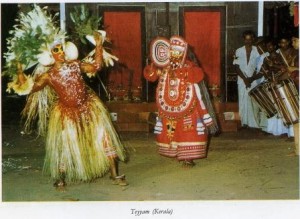
The Teyyam and Mudiettu of Kerala also come under the category of trance dance. The elements of theater are so pronounced in them that they are considered forms of ritual theatre. In Indian performing art traditions, theatre and dance are inseparable. Kathakali of Kerala is generally regarded as a form of classical dance, but if it is examined carefully one will come to the conclusion that it is basically a theatre. The difference between a group dance and theatre is that while the former may have narrative elements as theme, the latter has a definite plot and gradual development of character along the story line, which Kathakali has. Plays are specially written for Kathakali and they are called atta-kathas. In Manipuri Raasa dances Krishna while dancing with the Gopikas, suddenly vanish. Gopikas are heart broken. Krishna finally comes back and performs the raasa dances with the Gopikas. It is not a plot. It is a theme which is narrative in character. Considering from this perspective, one may say that Mudiettu has a plot of how the goddess Kali vanquishes the demon Darika in a fight. But the Teyyam does not have a definite plot. There are, of course, narrative elements which are quite dramatic. Therefore, we will consider Teyyam more a dance than a theatre.
Teyyam is derived from the word daivam meaning god. Each of the dancers is possessed either by a god or by an exalted legendary hero. Teyyam is widely in vogue in North Kerala, particularly in Cannanore district. When the dancer wears the full make-up and costume he is called a Teyyam. The make-up and costume, which are highly stylized, differ according to the Teyyam the dancer is required to represent. There are about 150 Teyyam in the traditional repertoire. The face of the dancer is given a mask like make-up with different bright colors. Each wear a towering and colorful headgear. At times, the headgear may be several feet high. The skirt is usually heavily pleated silk cloth. The dancers also wear many kinds of decorations made off tender fronds of coconut. The Teyyam with all these and heavy bangles and garlands appear much larger-than-life. After donning the costume the Teyyam goes through a ritual during which the invocatory chanting called Tottam is sung. This is for invoking the particular deity to enter into the body of the dancer. The dancer then executes some dance movements in slow tempo. Gradually the tempo becomes faster and faster and becomes a frenzied dancing leading to the trance.
Trance dances are becoming weaker day by day. It is so because the mind of the dancer at times is not that impression-able as the values of industrial civilization are creeping in to weaken the strength of the faith he had earlier for the deities. Keeping the dance movements and connected things quite authentic the dancer may, at times, feign the trance part of it.
